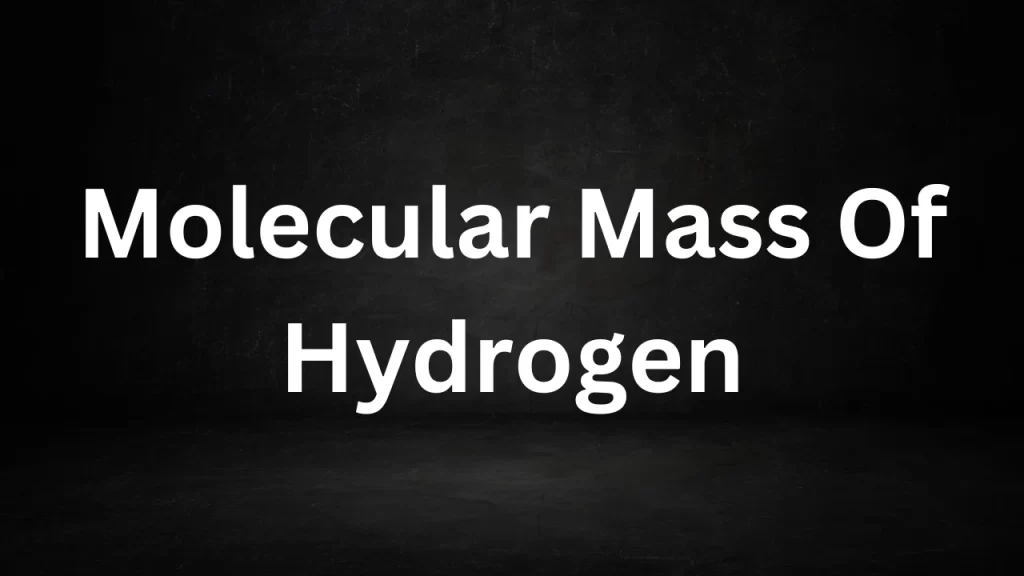Tag: hydrogen chloride molecular weight
Molecular Weight Of Cl
Molecular Weight Of Cl: Chlorine (Cl) is a chemical element with atomic number 17, making it one of the halogens in the periodic table.
It is a highly reactive and essential element used in various industries, including water treatment, chemical manufacturing, and the production of plastics. Understanding the molecular weight of chlorine is fundamental in chemistry, as it aids in various calculations and chemical reactions. In this article, we will explore the concept of molecular weight, discuss its significance in chemistry, and calculate the molecular weight of chlorine.

Molecular Weight Of Cl
Molecular Weight: An Important Concept
Mole weight, also known as molen mass or molar mass, is a crucial concept in chemistry. It represents the mass of one mole of a substance and is typically expressed in atomic mass units (amu) or unified atomic mass units (u). Calculating the molecular weight of a chemical element or compound involves summing the atomic masses of all the constituent atoms according to their proportions in the chemical formula.
Calculating the Molecular Weight of Chlorine
To calculate the mole weight of chlorine (Cl), we can use its atomic mass. The atomic mass of chlorine is approximately 35.45 atomic mass units (amu) or unified atomic mass units (u). Since chlorine exists as single atoms (Cl) and not as diatomic molecules (Cl2), its molecular weight is the same as its atomic mass.
Mole Weight of Chlorine (Cl) = Atomic Mass of Chlorine (Cl) Mole Weight of Chlorine (Cl) = 35.45 amu or 35.45 u
So, the mole weight of chlorine (Cl) is approximately 35.45 amu or 35.45 u.
Significance of Chlorine Molecular Weight
The mole weight of chlorine holds significance in various aspects of chemistry:
- Stoichiometry: Mole weight is essential in stoichiometry, allowing chemists to balance chemical equations and determine the quantities of reactants and products involved in chemical reactions that include chlorine.
- Chemical Reactions: Understanding the mole weight of chlorine aids in predicting its behavior in chemical reactions, calculating reaction yields, and determining product formation.
- Water Treatment: Chlorine is commonly used for water disinfection in municipal water treatment plants. Its molecular weight is important for accurately dosing chlorine to ensure safe drinking water.
- Chemical Manufacturing: Chlorine is a key raw material in various chemical processes, including the production of PVC (polyvinyl chloride) and chlorine-based solvents. Knowledge of its mole weight is crucial for quality control and process optimization.
- Analytical Chemistry: In analytical chemistry, mole weight measurements are often used for the identification and quantification of substances.
Conclusion
The mole weight of chlorine (Cl) is a fundamental concept in chemistry, with practical implications in various applications. By calculating its mole weight, chemists can make informed decisions, conduct precise experiments, and ensure the efficient utilization of chlorine in chemical processes, water treatment, and industrial applications. This understanding highlights the importance of mole weight in chemistry, allowing us to comprehend and control element properties effectively.
Read More
- Molecular Mass Of Sodium Carbonate
- Molecular Mass Of Nitric Acid
- Molecular Mass Of Sulphuric Acid
- Molar Mass Of Sulphuric Acid
- Types Of Motion In Physics
Frequently Asked Quetions (FAQs) OnMolecular Weight Of Cl
1. What is the molecular weight of chlorine (Cl)?
The mole weight of chlorine (Cl) is approximately 35.45 atomic mass units (amu) or unified atomic mass units (u).
2. What is molecular weight, and why is it important in chemistry?
Mole weight, also known as mole mass or molar mass, represents the mass of one mole of a substance and is expressed in atomic mass units (amu) or unified atomic mass units (u). It is crucial in chemistry for stoichiometry, balancing chemical equations, and various calculations.
3. How is the molecular weight of chlorine calculated?
The mole weight of chlorine is the same as its atomic mass, which is approximately 35.45 amu or 35.45 u. Chlorine exists as single atoms (Cl) and does not form diatomic molecules (Cl2).
4. Why is the molecular weight of chlorine significant in chemistry?
The mole weight of chlorine is important for stoichiometry, allowing chemists to balance chemical equations and determine reactant and product quantities accurately. It is also relevant in chemical reactions, water treatment, chemical manufacturing, and analytical chemistry.
5. Is chlorine always in its atomic form (Cl) in chemical reactions?
In most chemical reactions, chlorine exists as individual atoms (Cl) rather than diatomic molecules (Cl2). Therefore, its mole weight is equivalent to its atomic mass.
Molecular Mass Of Cl
Molecular Mass Of Cl: Chlorine, with the chemical symbol Cl, is a highly reactive chemical element classified under the halogen group in the periodic table.
Understanding the mole mass of chlorine is fundamental in chemistry, as it forms the basis for various scientific calculations and is essential for comprehending the properties and behavior of chlorine compounds.
This article will delve into the concept of mole mass, explain how it relates to chlorine, and discuss the significance of this knowledge in both theoretical and practical contexts.

Molecular Mass Of Cl
Molecular Mass: An Overview
The mole mass, also known as molar mass, is a fundamental concept in chemistry. It represents the mass of one mole of a particular substance and is typically expressed in atomic mass units (amu) or grams per mole (g/mol). A mole is a unit used to quantify the amount of a substance and contains approximately 6.022 x 10^23 entities, known as Avogadro’s number. Molecular mass is numerically equivalent to the atomic or mole weight of the substance.
The Molecular Mass of Chlorine (Cl)
Chlorine exists naturally as two stable isotopes: chlorine-35 (^35Cl) and chlorine-37 (^37Cl). The atomic masses of these isotopes are as follows:
- The atomic mass of chlorine-35 is approximately 34.97 amu.
- The atomic mass of chlorine-37 is approximately 36.97 amu.
To calculate the mole mass of chlorine (Cl), we consider the weighted average of the isotopic masses, taking into account their natural abundance. In the case of chlorine, approximately 75.77% is chlorine-35, and about 24.23% is chlorine-37.
mole Mass of Chlorine (Cl) = (0.7577 * Atomic Mass of ^35Cl) + (0.2423 * Atomic Mass of ^37Cl)
mole Mass of Chlorine (Cl) ≈ (0.7577 * 34.97 amu) + (0.2423 * 36.97 amu)
The mole Mass of Chlorine (Cl) ≈ 26.52 amu + 8.96 amu ≈ 35.48 amu
Significance of Molecular Mass of Chlorine
Understanding the mole mass of chlorine is significant in various scientific and practical applications:
1. Chemical Reactions:
- The mole mass of chlorine is crucial in chemical reactions involving chlorine compounds. It helps determine the stoichiometry, allowing chemists to balance equations and calculate reactant and product quantities accurately.
2. Analytical Chemistry:
- In analytical chemistry, the knowledge of molecular mass aids in the determination of concentrations, particularly in techniques like mass spectrometry and atomic spectroscopy.
3. Industrial Applications:
- Chlorine and its compounds have numerous industrial applications, including water treatment, the production of plastics, and the manufacture of chemicals. Knowledge of molecular mass is vital for precise formulation and quality control.
4. Environmental Sciences:
- mole mass plays a role in environmental studies, such as analyzing air and water composition, especially when evaluating chlorine’s impact on ecosystems and public health.
5. Medicine and Healthcare:
- Chlorine-based disinfectants are used in healthcare settings. Understanding mole mass is essential for medication formulations, water treatment processes, and ensuring the safety of medical products.
6. Material Science:
- Molecular mass is relevant in material science, especially when studying polymers and composite materials that may contain chlorine-based additives.
Conclusion
The mole mass of chlorine (Cl) is a fundamental concept in chemistry with wide-ranging applications across various scientific disciplines and industries. It enables precise calculations, facilitates the formulation of chemicals, contributes to environmental assessments, and plays a vital role in fields ranging from healthcare and water treatment to materials science and industrial chemistry. By comprehending the molecular mass of chlorine, scientists, chemists, and professionals can make informed decisions and contributions to diverse fields, ultimately benefiting society and advancing our understanding of the natural and engineered worlds.
Read More
- Molecular Mass Of Acetic Acid
- Molecular Weight Of Calcium Carbonate
- Molecular Weight Of Sodium Hydroxide
- Molecular Weight Of Aluminium
- Molecular Weight Of CaCl2
Frequently Asked Questions (FAQs) On Molecular Mass Of Cl
1. What is the molecular mass of chlorine (Cl)?
The mole mass of chlorine (Cl) is approximately 35.48 atomic mass units (amu). This value represents the weighted average of the two stable isotopes of chlorine, chlorine-35 and chlorine-37.
2. How is the molecular mass of chlorine calculated?
The mole mass of chlorine is calculated by considering the weighted average of the atomic masses of its naturally occurring isotopes, chlorine-35 and chlorine-37, taking into account their respective abundances.
3. Why is the molecular mass of chlorine important in chemistry?
The mole mass of chlorine is essential in chemistry as it helps determine the quantities of chlorine involved in chemical reactions, enabling accurate stoichiometric calculations and the balanced formulation of chemical equations.
4. What is the significance of the molecular mass of chlorine in analytical chemistry?
In analytical chemistry, knowledge of the mole mass of chlorine is crucial for determining concentrations of chlorine compounds, especially when using techniques like mass spectrometry and atomic spectroscopy.
5. Are there industrial applications related to the molecular mass of chlorine?
Yes, chlorine and its compounds have various industrial applications, including water treatment, plastics manufacturing, and chemical production. Understanding mole mass is vital for precise formulation and quality control in these industries.
Molecular Mass Of Hydrogen
Molecular Mass Of Hydrogen: H2, the lightest and most abundant element in the universe, plays a fundamental role in chemistry, physics, and astrophysics.
One key aspect of H2 is its molecular mass, a concept that underpins our understanding of chemical reactions, gas properties, and the composition of matter. In this article, we will explore the molecular mass of H2 and its significance.

Molecular Mass Of Hydrogen
The Basics of Molecular Mass
Molecular mass, also known as molecular weight or molar mass, is a crucial concept in chemistry. It represents the mass of a molecule and is typically expressed in atomic mass units (u) or unified atomic mass units (AMU). Molecular mass is calculated by summing the atomic masses of all the atoms in a molecule.
Hydrogen: The Simplest Element
H2 is the simplest and lightest element in the periodic table. It has an atomic number of 1, indicating that it has one proton in its nucleus. The most common and stable form of hydrogen is the diatomic molecule H2, where two hydrogen atoms are chemically bonded together.
Atomic Mass of Hydrogen
The atomic mass of H2 is approximately 1.00784 atomic mass units (u). This value accounts for the most common isotope of hydrogen, known as protium (¹H), which consists of one proton and one electron.
Calculating the Molecular Mass of Hydrogen (H2)
To calculate the molecular mass of hydrogen (H2), we simply add the atomic masses of the two hydrogen atoms in the molecule:
Molecular Mass of Hydrogen (H2) = (Atomic Mass of H2) x 2 Molecular Mass of Hydrogen (H2) ≈ (1.00784 u) x 2 ≈ 2.01588 u
Rounded to four decimal places, the molecular mass of hydrogen (H2) is approximately 2.0159 atomic mass units (u).
Significance of Hydrogen’s Molecular Mass
Understanding the molecular mass of H2 is of paramount importance in various scientific and practical contexts:
- Chemical Reactions: In chemical reactions involving hydrogen, its molecular mass is crucial for stoichiometry calculations. It helps determine the amount of H2 required or produced in a reaction.
- Gas Properties: H2 is used as a fuel and in gas mixtures for various applications. Its molecular mass influences its behavior as a gas, including density, solubility, and combustion properties.
- Energy Storage: Hydrogen is considered a clean and efficient energy carrier. Its molecular mass affects the energy density of hydrogen fuels and their storage and transportation.
- Astrophysics: Understanding the molecular mass of H2 is vital in astrophysics, where H2 is the primary element in stars and the universe’s most abundant element.
- H2 Bonding: H2 bonds with other elements and molecules, and its molecular mass influences the strength and characteristics of these bonds.
- Fuel Cells: In H2 fuel cells, which are used for power generation and transportation, the molecular mass of H2 plays a role in efficiency calculations.
Conclusion
The molecular mass of hydrogen (H2), approximately 2.0159 atomic mass units (u), is a fundamental property of this elemental gas. Its significance extends from the microscopic world of chemical reactions to the vast reaches of the universe in astrophysics. Whether it’s powering vehicles, fueling stars, or driving chemical reactions in the laboratory, the molecular mass of H2 is a foundational concept that enriches our understanding of the physical and chemical properties of matter.
Read More
- Molecular Mass Of Nacl
- Molecular Mass Of Naoh
- Molecular Mass Of Nitrogen
- Molecular Weight Of Glucose
- Molecular Mass Of Oxygen
Frequently Asked Question (FAQs) Molecular Mass Of H2
1. What is the molecular mass of hydrogen (H2)?
The molecular mass of hydrogen (H2) is approximately 2.0159 atomic mass units (u). This value is calculated by adding the atomic masses of the two H2 atoms in the molecule.
2. Why is the molecular mass of H2 significant?
The molecular mass of H2 is essential in various scientific fields, including chemistry, physics, and astrophysics. It influences chemical reactions, gas properties, energy storage, and our understanding of the universe.
3. How is the molecular mass of H2 calculated?
The molecular mass of hydrogen (H2) is calculated by multiplying the atomic mass of H2 by 2, as there are two H2 atoms in the H2 molecule. The atomic mass of H2 is approximately 1.00784 atomic mass units (u).
4. What are the implications of H2 molecular mass in chemical reactions?
Hydrogen’s molecular mass is crucial in stoichiometry calculations, helping determine the quantities of H2 involved in chemical reactions. It plays a fundamental role in chemical synthesis and analysis.
5. How does H2 molecular mass affect its behavior as a gas?
Hydrogen’s molecular mass influences its gas properties, including density, solubility, and combustion characteristics. It is used as a fuel in various applications due to its low molecular mass and high energy content.